A Reference to a Well Known Piece of Art Mythology

Those who are well-versed in Greek mythology probable recognize many scenes from myths in famous artworks. In fact, apart from religious scenes, images from Greek mythology are one of the most common themes in European art.
Greek mythology is prominent in art dating from artifact through to the renaissance and even in contemporary artwork.
During the Renaissance particularly, Greek and Roman mythology became very pop due to a renewed interest in artifact brought about past humanism.
The cultured and educated elite prided themselves on deep knowledge of aboriginal Greek and Roman art, literature, culture, and history, which naturally involved a report Greek mythology.
Scenes of nymphs, gods, and mythic creatures such as satyrs are common in art of the Renaissance, and as the period served as the foundation for much of afterward European fine art, these themes carried on throughout the centuries.

While mythology is a popular theme in art generally, in that location are a number of specific myths that are peculiarly common in great works of art.

The Three Graces are common figures from Greek mythology found in art
While Botticelli's masterwork "Primavera" features countless figures from Greek and Roman mythology, the iii women in diaphanous garments in the foreground are specially iconic figures — the three Graces.
The three Graces, or Charities, are found throughout centuries of art history. They are easily identifiable equally they are almost always depicted together.
About oft, they are shown as iii cute, nude women clasping hands or belongings onto each other's shoulders. Frequently, the ii Graces flanking the 3rd are depicted facing the viewer, while the woman in the middle has her back to the viewer.
In Greek mythology, the iii figures are known as the Charities, but they were chosen the "Gratiae," or Graces, in Roman myth. Collectively, they are considered the goddess of beauty, charm, creativity, and goodwill, and their roles oftentimes changed from myth to myth.
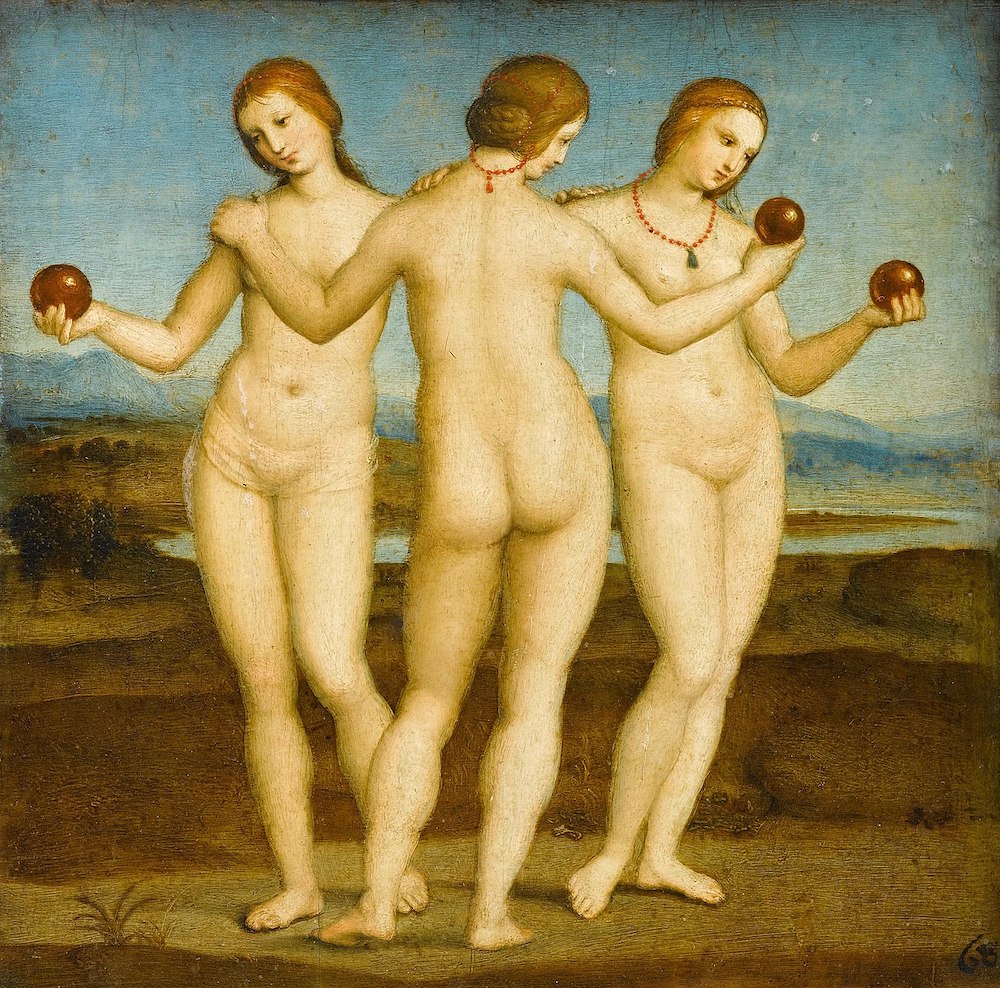
The Graces, Aglaea, "Shining," Euphrosyne,"Joy," and Thalia, "Blooming," are ofttimes referred to every bit the daughters of Zeus and an Oceanid named Eurynome. Homer associates the three women with Aphrodite, the goddess of Honey.
Their well-nigh important role in Greek myth was every bit attendants to the twelve Olympian gods. Frequently, they are described equally either preparing a feast for the gods, or dancing for them. They also assistance Aphrodite bathe and become dressed, and fifty-fifty weave her clothes.
Worship of the goddesses is quite ancient, as many scholars argue that their cult dates back to the Pelasgians, or the archaic ancestors of the ancient Greeks.
The story of the Trojan State of war
Scenes from the Iliad and Odyssey are very common in art, every bit knowledge of the "Iliad" and the "Odyssey" was considered a part of bones education for centuries. It was expected that near educated people would immediately recognize scenes from the war upon seeing them depicted in a painting.
Although many scholars take debated whether or not the Trojan State of war equally we know it from the works of the bully poet Homer truly occurred, it is generally agreed upon that the Trojan War equally described in the Iliad and the Odyssey can exist considered myth.
In fact, it is believed to be 1 of the about important and foundational stories in Greek mythology. Featuring some of the most iconic figures from myth, including Agamemnon, Achilles, Paris, Hector, and of course a number of the Olympian gods, scenes from the Trojan War feature prominently in European art.

The Trojan State of war began after the Trojan prince Paris took Helen, wife of the Spartan king Menelaus, back with him to Troy. Paris had been promised the mitt of the nigh beautiful woman in the earth after he deemed Aphrodite the near beautiful in a contest against Hera and Athena.
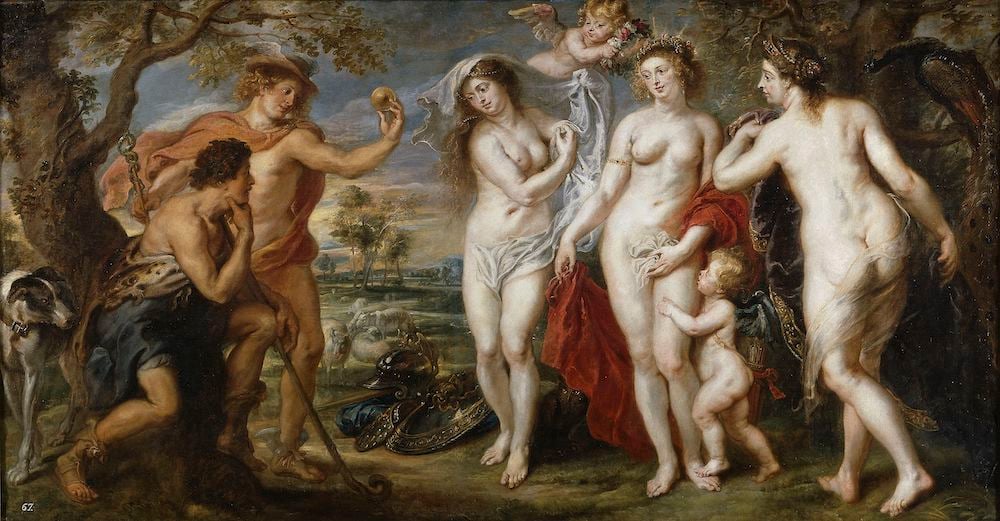
This act brought most 10 years of fighting, and the Greeks besieged the city of Troy for a decade before finally gaining admission to the metropolis by using the famous Trojan horse.
Some of the nearly widely-depicted fighters from the Trojan War are Achilles, Patroclus, and Hector, who were involved in one of the most famous episodes from the war.
Hector was the greatest of all Trojan warriors — so great that even his enemies, the Greeks, admired him. Achilles, the greatest of the Greek warriors, before long became the target of Hector.
The Trojan warrior wanted nothing more than to defeat his enemy in battle, merely Achilles refused to fight after the Mycenaean male monarch Agamemnon took abroad his "battle prize," a Trojan adult female named Briseis.

While Achilles sat in his tent, fuming over the loss of Briseis, Patroclus, his closest friend and who many argue may have been his lover, donned the Greek hero's distinctive armor and went to battle.
Thinking that Patroclus was Achilles, equally he was wearing the warrior's iconic armor, Hector killed him.
When word got back to Achilles, he was so enraged that he went on a killing spree, massacring the Trojan forces, while seeking out Hector.
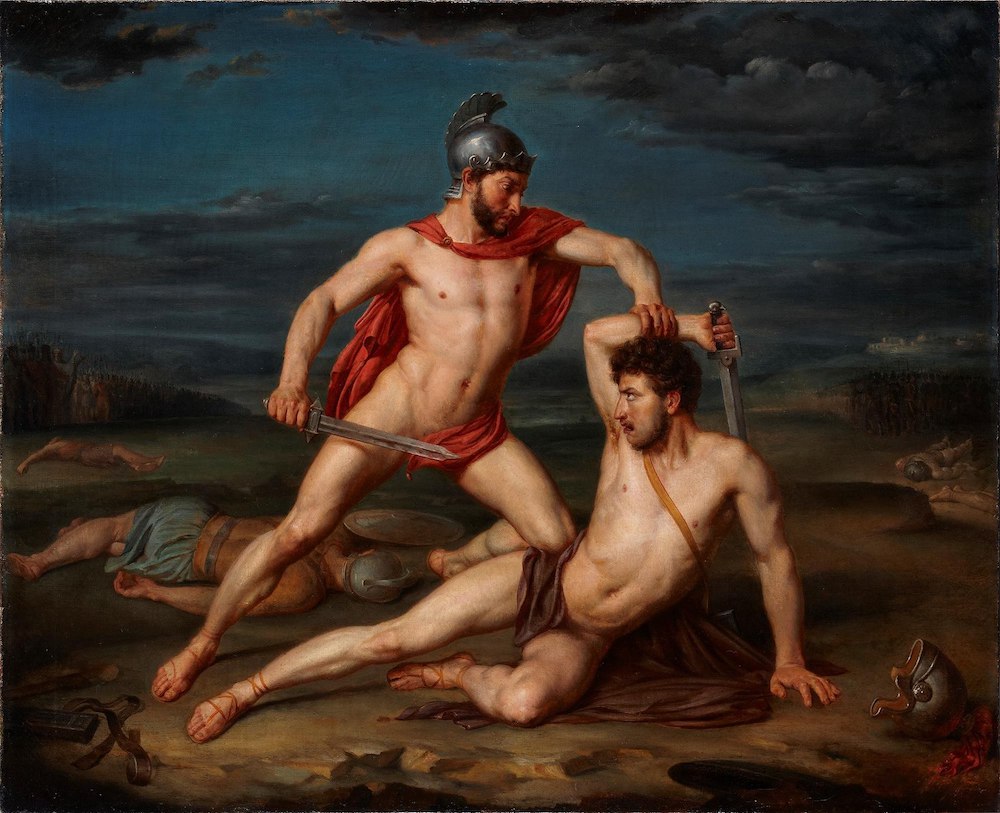
When he finally plant the warrior, he chased him around the walls of Troy three times until Hector was convinced to face Achilles face-to-face past the goddess Athena.
Hector accepted that he would likely exist killed past Achilles afterward he tried to strike the hero and missed. Rather than plead for his life, Hector simply requested that his body exist treated with respect later on his decease.
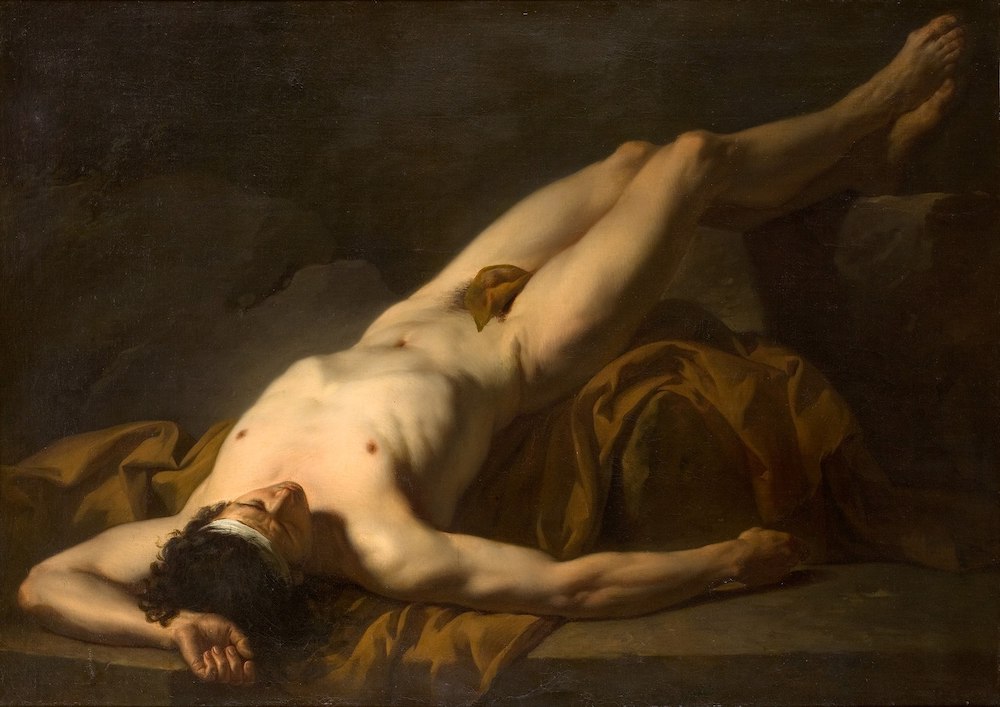
Simply Achilles, full of rage, dragged Hector'southward body by its heels with his chariot around the city's walls. The corpse of Hector was a frequent subject of paintings, and is even alluded to in the famous work "Freedom Leading the People" by French painter Delacroix.
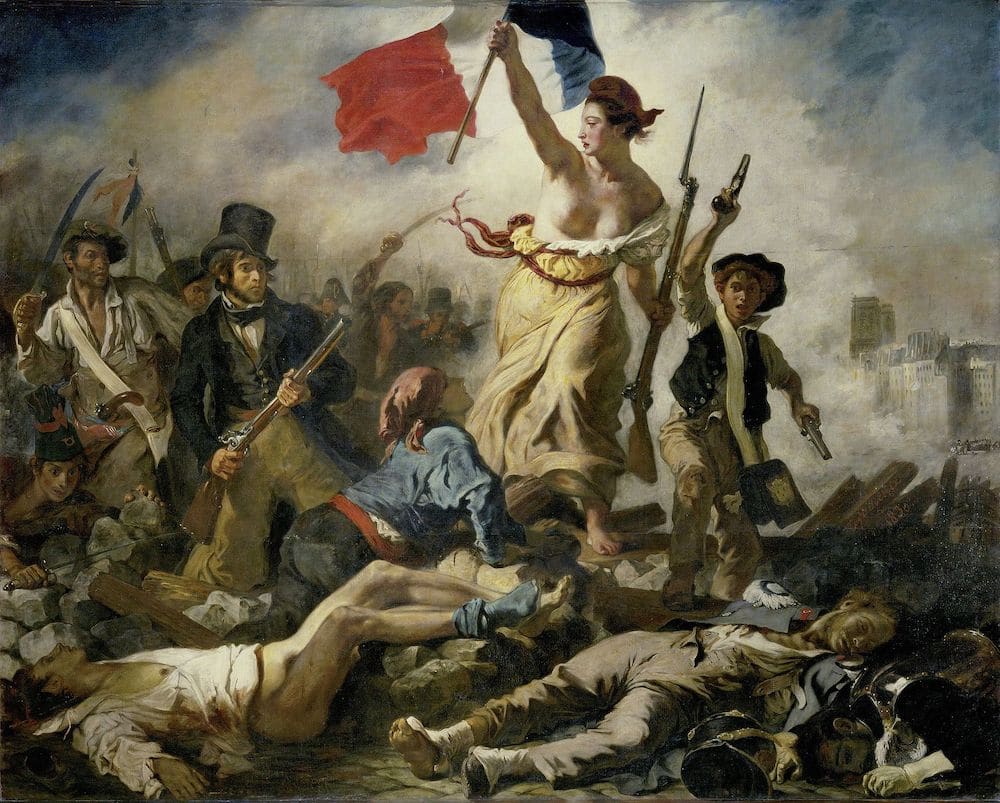
American artist Cy Twombly, who frequently drew inspiration from Greek myth in his artwork, explored the story of Achilles, Hector, and Patroclus in his 1978 work "Fifty Days at Iliam: Shades of Achilles, Patroclus, and Hector."
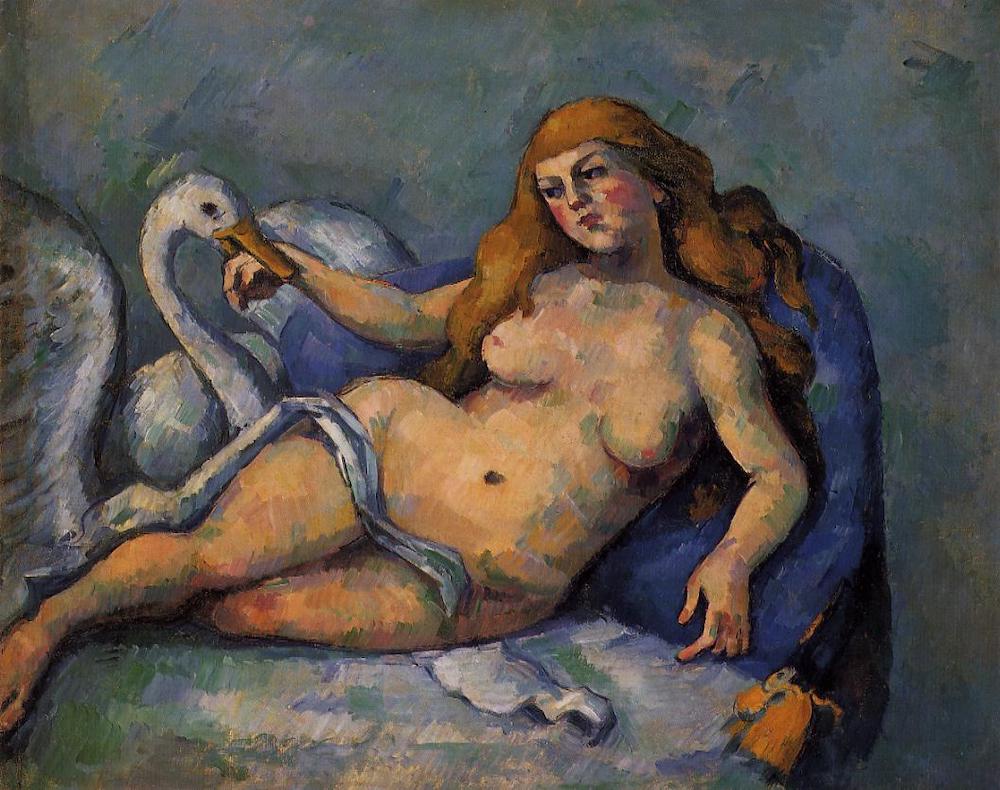
Leda and the Swan: Greek mythology and eroticism in art
Zeus, king of the Olympian gods, was known for his infidelity to his wife, Hera. In 1 of the most famous and surely nigh bizarre myths on the subject, Zeus transforms into a swan in gild to seduce the beautiful Leda, who was already married to the Spartan rex Tyndareus.
Every bit a swan, Zeus tricked Leda by falling into her arms after being pursued past an eagle. According to myth, the sexual act, which many consider nonconsensual, occurred on the aforementioned night that Leda had sex with her husband.
And so, subsequently falling pregnant, Leda "gave birth" to two eggs, ane of which independent Helen of Troy, Clytemnestra, famed wife and murderer of Agamemnon, and the twins Castor and Pollux, who were known as the Dioscuri.
The paternity of the children varies from myth to myth, merely nigh commonly, Helen and 1 of the twins, Pollux, are the children of Zeus, and the others, Clytemnestra and Brush, are fully mortal.
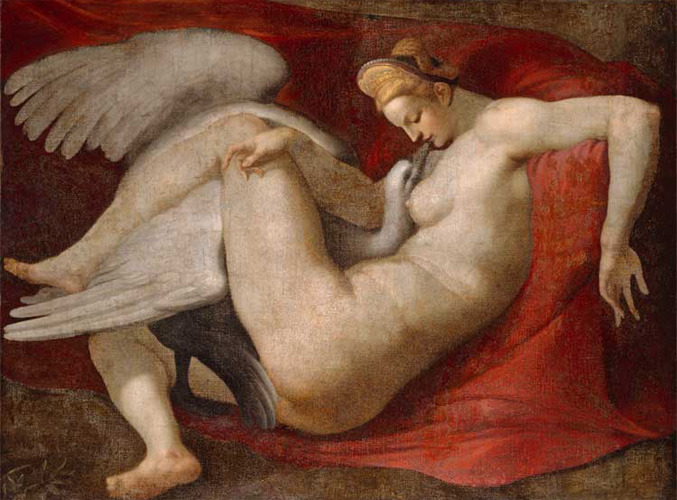
The story of Leda and the Swan became wildly pop in Renaissance artwork. Both Leonardo da Vinci and Michelangelo both painted the scene, but the originals of their piece of work are now lost, and only copies from other artists remain.
Most art historians believe that the two works were likely destroyed deliberately, as the scene was considered highly erotic at the time.
Painters were more free to paint overtly erotic works on the theme than they would be if the couple had been ii human beings, but the scene yet inspired controversy amidst people who objected to eroticism in art.
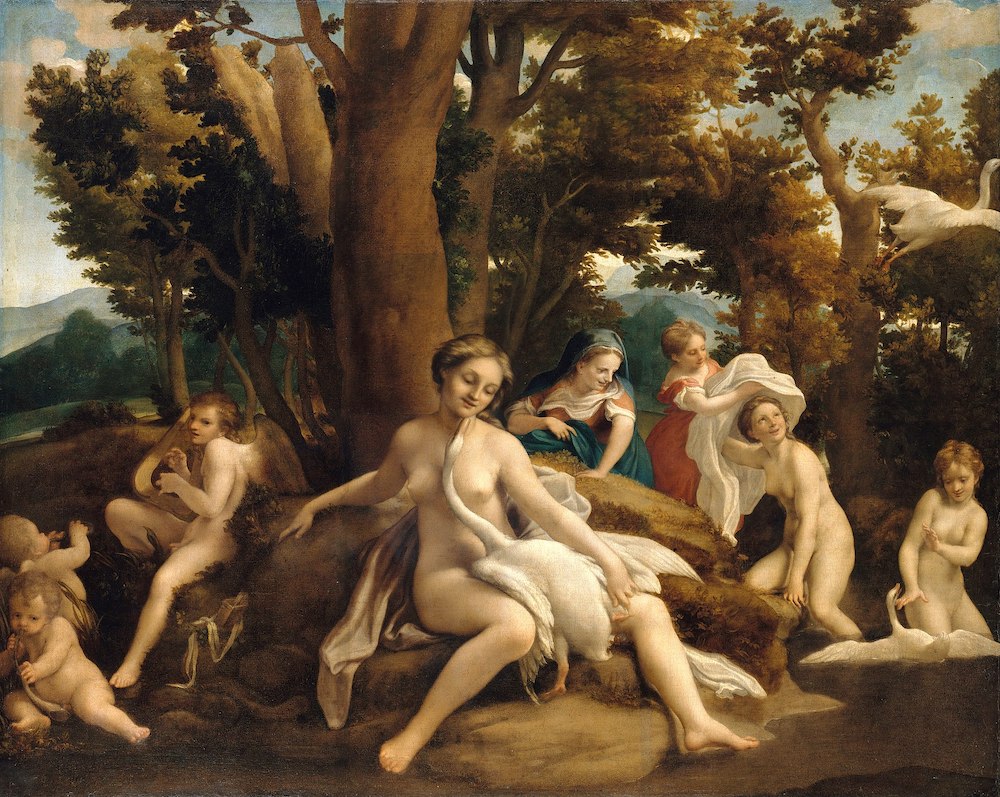
The nearly famous surviving work featuring the scene in Renaissance fine art is "Leda and the Swan" past Coreggio, but it was not immune from damage and controversy either. It was attacked with a knife by Louis, son of Philippe Ii, the Duke of Orleans, while in his collection.
Louis was known to dear painting, but was also guilty nigh his life of excess and sex, which was likely the reason for the set on.
The story of Leda and the Swan was also the inspiration for William Butler Yeats' 1923 sonnet of the same proper noun. The work is known as a masterpiece, as it both tells of the trigger-happy rape of Leda, every bit well as the events that the attack brings most — the Trojan War and the decease of Agamemnon.
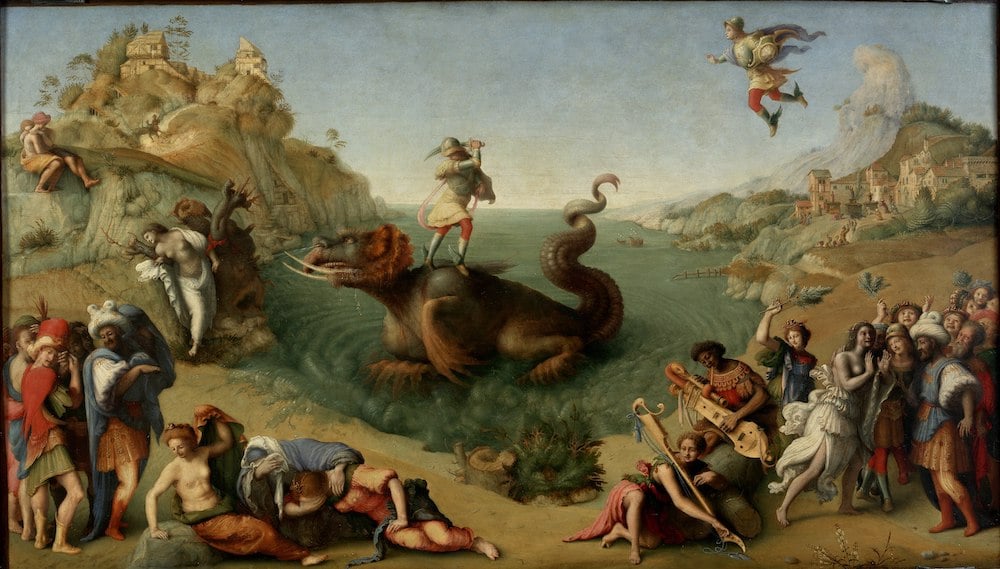
Perseus freeing Andromeda
The scene in which the Greek hero Perseus swoops in to save Andromeda, perhaps the first "dryad in distress," was a favorite of painters, every bit it allowed them to pigment a beautiful nude woman, a fearsome body of water monster, and a beautiful seaside landscape.
Co-ordinate to Greek myth, Andromeda, an Ethiopian princess is chained to a rock every bit a sacrifice to a horrifying sea monster. The monster, named Cetus, began to torment the kingdom after the princess' female parent Cassiopeia began to claim that she was more beautiful than the Nereids, or the sea nymphs who accompanied Poseidon.
The god of the bounding main punished Cassiopeia for her arrogance by sending Cetus to the Ethiopian coasts. Subsequently seeking advice from an oracle, Andromeda's father, the king Cepheus, learns that he must sacrifice his girl.
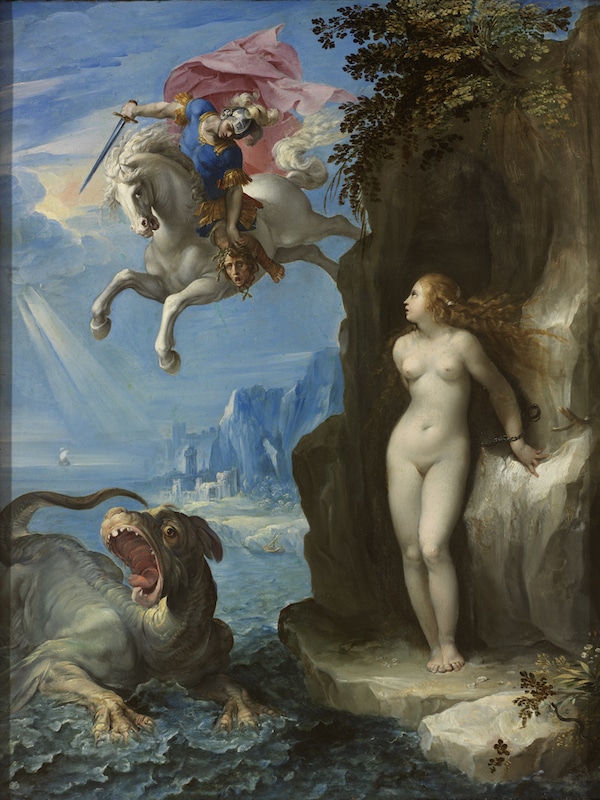
He then chained her to a rock along the sea, where she could be eaten by the terrifying sea monster.
Luckily, however, Perseus happened to be flying by the declension of Ethiopia on his winged sandals afterward killing Medusa.
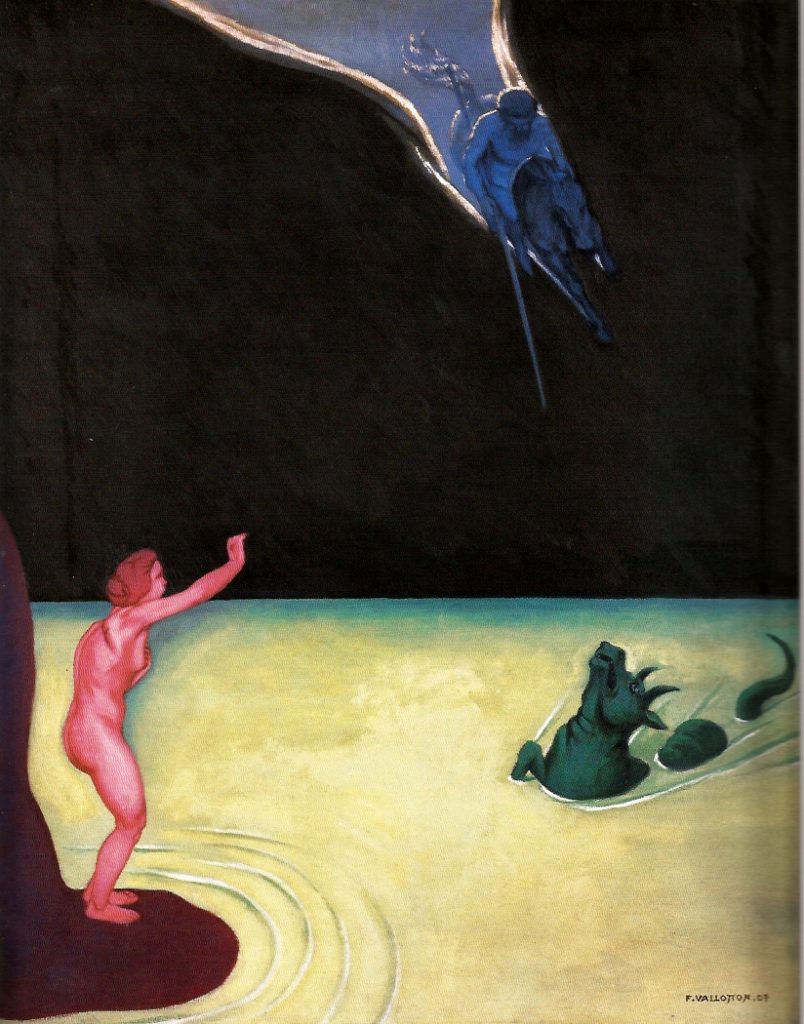
Upon seeing her as he flew by, Perseus savage in love with Andromeda, and immediately went to ask her father Cepheus for her paw in spousal relationship. The rex agreed, but only if Perseus could save his daughter and impale the monster in his seas.
The hero manages to kill the beast with the same sword, called "Harpe," that he had used to impale Medusa.
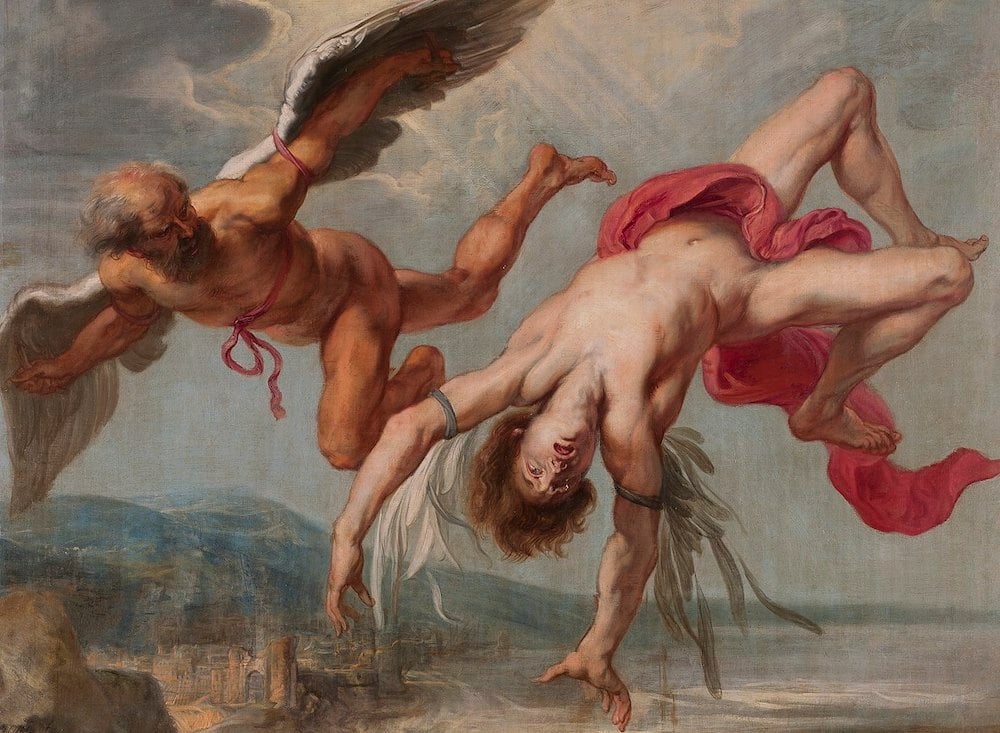
Icarus
The famous story of Daedalus and Icarus, the boy who flew too close to the dominicus, is one of the most well-known tales from Greek myth.
According to the story, variations of which are found in the works of Greek writers Homer and Herodotus, and the Romans Ovid and Virgil, the cracking artisan Daedalus searches for a way to escape the complex labyrinth of his own making with his son, Icarus.
The father and son were trapped in the maze by King Minos, who ordered Daedalus to construct the labyrinth to hibernate the Minotaur, a fearsome animal and the product of his wife Pasiphae's affair with a bull.
In gild to leave the labyrinth, Daedalus decided to construct wings of wax and feathers for himself and his son, Icarus, and then they could fly.
When the moment to escape arrived, Daedalus warned Icarus non to wing besides close to the sun, but the ill-behaved male child did not listen to his father and he roughshod into the sea when the wax in his wings melted and fell apart from the heat of the sun'south rays.
While many depictions of the famous myth focus on the figure of Icarus and the moment he begins to fall, the almost well-known depiction of the painting almost ignores the crucial moment completely.
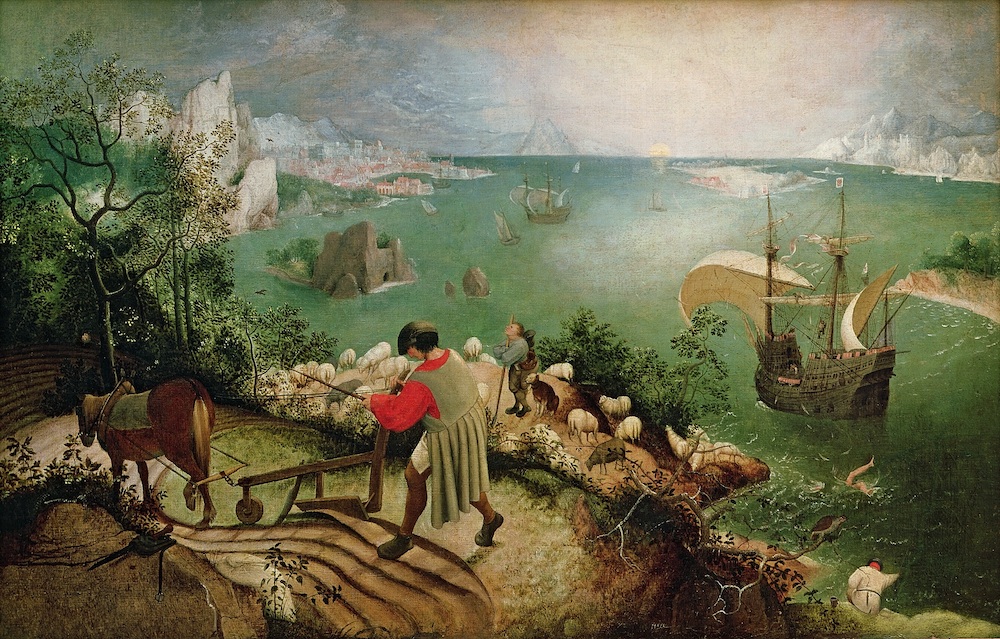
About viewers continuing earlier Pieter Bruegel the Elder's "Mural with the Fall of Icarus" likely practice not even spot Icarus at outset glance.
Instead, they adore the intricate landscape, which features men working in the fields, the bounding main, and even cities far in the groundwork.
Upon closer inspection, nonetheless, ane can brand out a small pair of legs flailing in the sea in the lower right corner of the work.
The scene depicts the moments afterward Icarus plunged from the heaven into the bounding main, and focuses on the world effectually him instead of on the dramatic moment.
In this work, Bruegel is exploring the version of the myth told by the ancient Roman poet Ovid in his famous work "Metamorphoses," which describes a fisherman, plowman, and shepherd at the scene. Ovid describes them equally "astonished" every bit they marvel at the pair flying above them, yet Bruegel shows them all hard at work, except for the shepherd, who presumably looks up at Daedalus, who is not featured in the painting.
"ICARUS" Henri Matisse: The Cut-Outs #matisse #tatelondon #icarus motion picture.twitter.com/F4owkZmSYJ
— Thousand two iii (@M23projects) July 3, 2014
The swell French creative person Matisse too explored the theme of Icarus in i of his famous Cut-Outs, which were fabricated out of paper. His piece of work "Icarus" was included in his illustrated volume "Jazz," which was released in 1947.
Notably, Matisse'southward figure does not have wings at all, and seems to float in infinite, surrounded past the stars. In his version, the once tragic effigy may not take fallen at all after losing his wings, merely ascended even farther into space. Conversely, it could depict the moment earlier Icarus falls out of the sky.
Source: https://greekreporter.com/2022/03/03/greek-myths-art-history-paintings/
0 Response to "A Reference to a Well Known Piece of Art Mythology"
Post a Comment